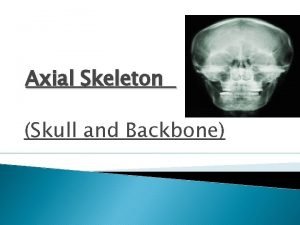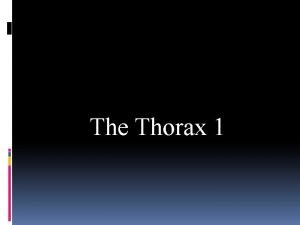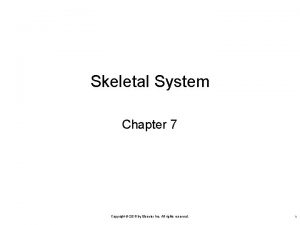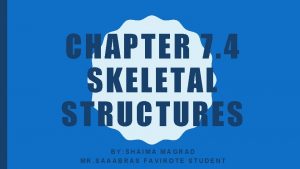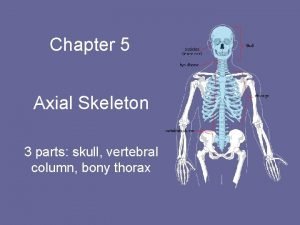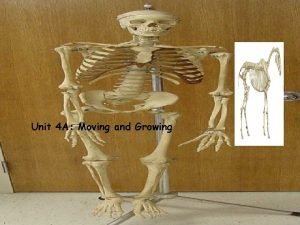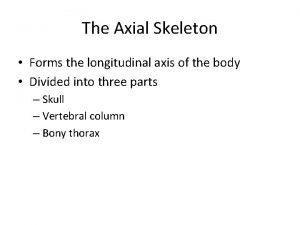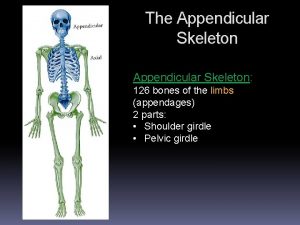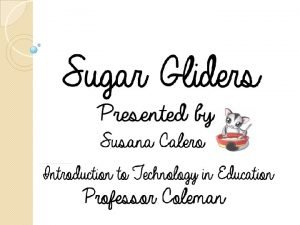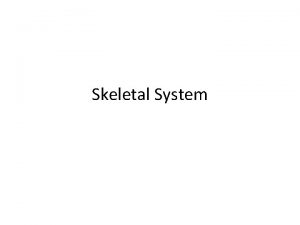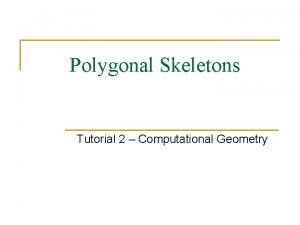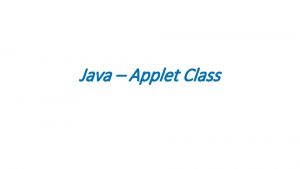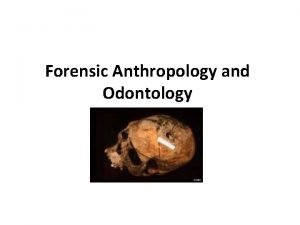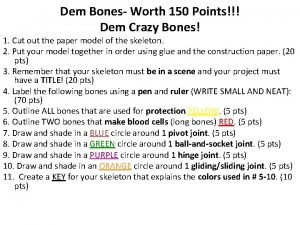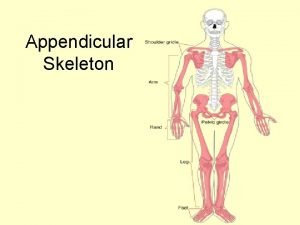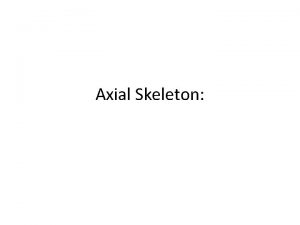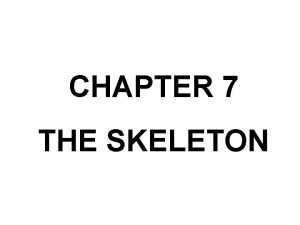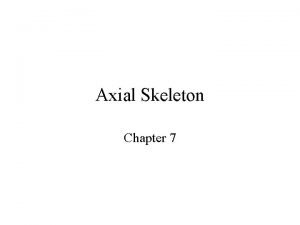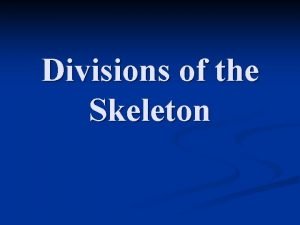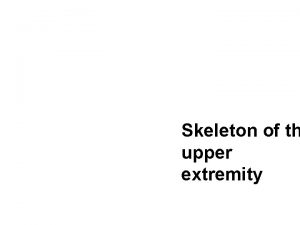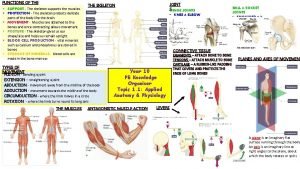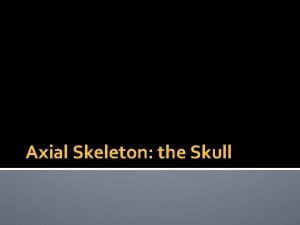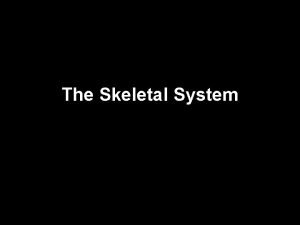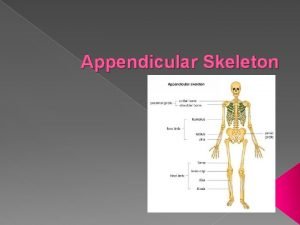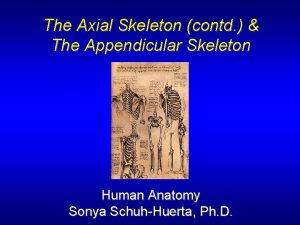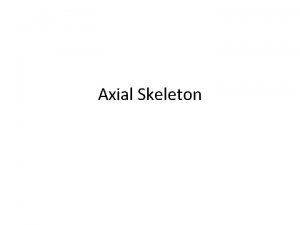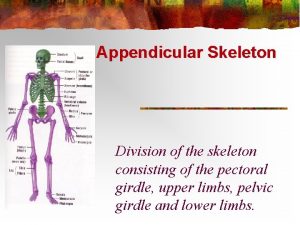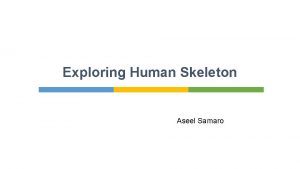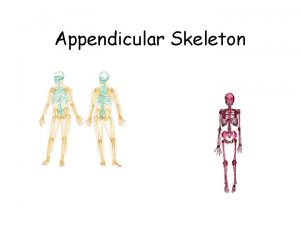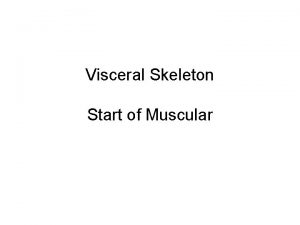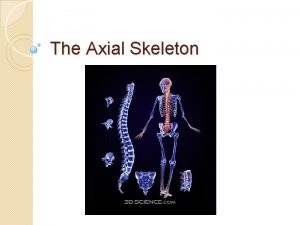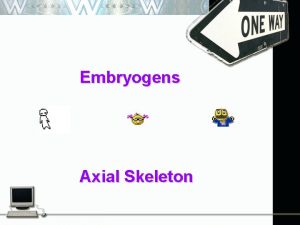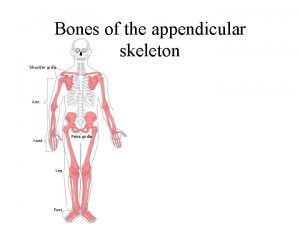The Skeleton Chapter 7 Part A The Skeleton









































































- Slides: 73

The Skeleton Chapter 7 Part A

The Skeleton • Skeleton = Greek for ‘dried up body’ or ‘mummy’ • Composed of bones, cartilages, joints, and ligaments – Mostly bone – Ligaments connects bones and reinforces joints

The Skeleton • About 20% of body mass – 160 pound person would have about 30 pound skeleton • Classified into 2 parts – Axial and Appendicular

The Axial Skeleton • 80 bones in 3 regions – Skull – Vertebral column – Bony thorax • Supports the head, neck, trunk • Protects the brain, spinal cord, and the organs in the thorax

The Axial Skeleton in Green Figure 5. 6 Copyright © 2003 Pearson Education, Inc. publishing as Benjamin Cummings Slide 5. 20 b

The Skull • Most complex structure – 22 bones – mostly flat • Two sets of bones – Cranium – Facial bones

The Skull • Bones are joined by sutures – Except mandible • Sutures are interlocking joints – saw-toothed or serrated appearance • Only the mandible is attached by a freely movable joint

The Skull • • • Major skull sutures are Coronal Sagittal Squamous Lambdoid

The Skull • Cranial bones or cranium – Protects brain – Site of attachment for head and neck muscles

The Skull • Facial bones – Framework for face – Cavities for special sense organs of sight taste and smell – Openings for air and food passage – Secure teeth – Anchor facial muscles of expression

Anatomy of the Cranium • • Eight cranial bones – two Parietal two Temporal Frontal Occipital Sphenoid Ethmoid Cranial bones are thin and remarkably strong for their weight

Frontal Bone • Forms the anterior portion of the cranium • Articulates posteriorly with the parietal bones via the coronal suture • In yellow

Frontal Bone • Major markings – Frontal squama (forehead) – supraorbital margins – Supraorbital foramen – the anterior cranial fossa – the frontal sinuses – glabulla

Parietal Bones • Two curved retangular bones that form most of the superior and lateral aspects of skull • In Green

Parietal Bones and Major Associated Sutures • Four sutures mark the articulations of the parietal bones – Coronal suture – articulation between parietal bones and frontal bone anteriorly – Sagittal suture – where right and left parietal bones meet superiorly

Parietal Bones and Major Associated Sutures • Four sutures mark the articulations of the parietal bones – Lambdoid suture – where parietal bones meet the occipital bone posteriorly – Squamosal or squamous suture – where parietal and temporal bones meet

Skull: Posterior View Parietal bones in maroon Figure 7. 2 b

Occipital Bone • Forms most of skull’s posterior wall and base • Occiptal bone in brown Figure 7. 2 b

Occipital Bone • Forms most of skull’s posterior wall and base • Major markings – Posterior cranial fossa (inside) – Foramen magnum – Occipital condyles – Hypoglossal canal – External occipital protuberance (you can feel this) Figure 7. 2 b

Human Skull, Inferior View Figure 5. 9 Copyright © 2003 Pearson Education, Inc. publishing as Benjamin Cummings Slide 5. 24

Temporal Bones • Temple and temporal are latin words for ‘time’ – Gray hair usually appears first at the temples

• Divided into four major Temporal regions – Squamous – Tympanic • Ear drum – Mastoid – Petrous • Contributes to the cranial base • Houses middle and inner ear cavities Bones

Human Skull, Inferior View Figure 5. 9 Copyright © 2003 Pearson Education, Inc. publishing as Benjamin Cummings Slide 5. 24

Temporal Bones • Major markings – Zygomatic process (squamous region) • Zygomatic process meets zygomatic bone of face – you can feel this – your cheek bone

Temporal Bones • Major markings – Styloid process (needle like projection in the tympanic region)

Temporal Bones • Major markings – Mastoid process (felt as a lump posterior to the ear) – Mandibular fossae – Middle cranial fossae ( in Petrous region)

Temporal Bones • Major openings – stylomastoid foramina – jugular foramina – external and internal auditory meatuses (ear canal) – carotid canal

Sphenoid Bone • Butterfly-shaped bone that spans the width of the middle cranial fossa • Forms the central wedge that articulates with all other cranial bones • Consists of a central body, greater wings, lesser wings, and pterygoid processes • Major markings: the sella turcica, hypophyseal fossa, and the pterygoid processes • Major openings include the foramina rotundum, ovale, and spinosum; the optic canals; and the superior orbital fissure

Human Skull, Superior View Sphenoid Bone in pink Figure 5. 8 Copyright © 2003 Pearson Education, Inc. publishing as Benjamin Cummings Slide 5. 23

Sphenoid Bone Figure 7. 6 a, b

Ethmoid Bone • Most deep of the skull bones; lies between the sphenoid and nasal bones • Forms most of the bony area between the nasal cavity and the orbits

Ethmoid Bone • Major markings – cribriform plate – crista galli – perpendicular plate – nasal conchae – ethmoid sinuses

Human Skull, Superior View Figure 5. 8 Copyright © 2003 Pearson Education, Inc. publishing as Benjamin Cummings Slide 5. 23

Human Skull, Inferior View Figure 5. 9 Copyright © 2003 Pearson Education, Inc. publishing as Benjamin Cummings Slide 5. 24

Wormian Bones • Also called sutural bones • Tiny irregularly shaped bones that appear within sutures • Structurally unimportant • Not all skulls exhibit them

Facial Bones

Facial Bones • Fourteen bones of which only the mandible and vomer are unpaired • The paired bones are the maxillae, zygomatics, nasals, lacrimals, palatines, and inferior conchae • Usually facial bones of men are more elongated than of women

Mandible and Its Markings • The mandible (lower jawbone) is the largest, strongest bone of the face

Mandible and Its Markings • Its major markings include the coronoid process, mandibular condyle, the alveolar margin, and the mandibular and mental foramina

Mandible and Its Markings • Dentists inject Novocain into the mandibular foramina to numb teeth

Maxillary Bones • Medially fused bones that make up the upper jaw and the central portion of the facial skeleton

Maxillary Bones • Facial keystone bones that articulate with all other facial bones except the mandible

Maxillary Bones • Their major markings include palatine, frontal, and zygomatic processes, the alveolar margins, inferior orbital fissure, and the maxillary sinuses

Zygomatic Bones • Irregularly shaped bones (cheekbones) that form the prominences of the cheeks and the inferolateral margins of the orbits In Teal

Other Facial Bones • Nasal bones – thin medially fused bones that form the bridge of the nose

Other Facial Bones • Lacrimal bones – contribute to the medial walls of the orbit and contain a deep groove called the lacrimal fossa that houses the lacrimal sac

Other Facial Bones • Palatine bones – two bone plates that form portions of the hard palate, the posterolateral walls of the nasal cavity, and a small part of the orbits

Other Facial Bones • Vomer – plowshaped bone that forms part of the nasal septum

Other Facial Bones • Inferior nasal conchae – paired, curved bones in the nasal cavity that form part of the lateral walls of the nasal cavity

Orbits • Bony cavities in which the eyes are firmly encased and cushioned by fatty tissue • Formed by parts of seven bones – frontal, sphenoid, zygomatic, maxilla, palatine, lacrimal, and ethmoid

Orbits Figure 7. 9 b

Nasal Cavity • Constructed of bone and hyaline cartilage • Roof – formed by the cribriform plate of the ethmoid

Nasal Cavity • Lateral walls – formed by the superior and middle conchae of the ethmoid, the perpendicular plate of the palatine, and the inferior nasal conchae • Floor – formed by palatine process of the maxillae and palatine bone

Paranasal Sinuses · Hollow portions of bones surrounding the nasal cavity Figure 5. 10 Copyright © 2003 Pearson Education, Inc. publishing as Benjamin Cummings Slide 5. 25 a

Paranasal Sinuses • Mucosa-lined, air-filled sacs found in five skull bones – the frontal, sphenoid, ethmoid, and paired maxillary bones

Paranasal Sinuses • Air enters the paranasal sinuses from the nasal cavity and mucus drains into the nasal cavity from the sinuses

Paranasal Sinuses • Lighten the skull and enhance the resonance of the voice and amplifies Figure 7. 11

Hyoid Bone • Not actually part of the skull, but lies just inferior to the mandible in the anterior neck • Only bone of the body that does not articulate directly with another bone • Attachment point for neck muscles that raise and lower the larynx during swallowing and speech

The Hyoid Bone · The only bone that does not articulate with another bone · Serves as a moveable base for the tongue Figure 5. 12 Copyright © 2003 Pearson Education, Inc. publishing as Benjamin Cummings Slide 5. 26

The Fetal Skull · The fetal skull is large compared to the infants total body length Figure 5. 13 Copyright © 2003 Pearson Education, Inc. publishing as Benjamin Cummings Slide 5. 27 a

The Fetal Skull · Fontanelles – fibrous membranes connecting the cranial bones · Allow the brain to grow · Convert to bone within 24 months after birth Figure 5. 13 Copyright © 2003 Pearson Education, Inc. publishing as Benjamin Cummings Slide 5. 27 b

Quiz – Next time! Complete study guide Pages 143 - 150

Skull: Anterior View Figure 7. 2 a

Parietal Bones and Major Associated Sutures • Form most of the superior and lateral aspects of the skull Figure 7. 3 a

Occipital Bone and Its Major Markings Figure 7. 4 b

Anterior Aspects of the Skull Figure 7. 2 a

Posterior Aspects of the Skull Figure 7. 2 b

External Lateral Aspects of the Skull Figure 7. 3 a

Midsagittal Lateral Aspects of the Skull Figure 7. 3 b

Inferior Portion of the Skull Figure 7. 4 a

Inferior Portion of the Skull Figure 7. 4 b

Quiz – Next time! Complete study guide

 Axial vs appendicular skeletal system
Axial vs appendicular skeletal system Axial skeleton vs appendicular
Axial skeleton vs appendicular Axial vs appendicular skeleton
Axial vs appendicular skeleton Part part whole addition
Part part whole addition Part to part ratio definition
Part to part ratio definition Brainpop ratios
Brainpop ratios Define technical description
Define technical description Parts of a bar counter
Parts of a bar counter The phase of the moon you see depends on ______.
The phase of the moon you see depends on ______. 미니탭 gage r&r 해석
미니탭 gage r&r 해석 Elsevier
Elsevier 7:4 skeletal system
7:4 skeletal system Chapter 5 the skeletal system axial skeleton skull
Chapter 5 the skeletal system axial skeleton skull Receive
Receive Hình ảnh bộ gõ cơ thể búng tay
Hình ảnh bộ gõ cơ thể búng tay Frameset trong html5
Frameset trong html5 Bổ thể
Bổ thể Tỉ lệ cơ thể trẻ em
Tỉ lệ cơ thể trẻ em Voi kéo gỗ như thế nào
Voi kéo gỗ như thế nào Chụp phim tư thế worms-breton
Chụp phim tư thế worms-breton Chúa yêu trần thế
Chúa yêu trần thế Kể tên các môn thể thao
Kể tên các môn thể thao Thế nào là hệ số cao nhất
Thế nào là hệ số cao nhất Các châu lục và đại dương trên thế giới
Các châu lục và đại dương trên thế giới Công thức tính độ biến thiên đông lượng
Công thức tính độ biến thiên đông lượng Trời xanh đây là của chúng ta thể thơ
Trời xanh đây là của chúng ta thể thơ Mật thư tọa độ 5x5
Mật thư tọa độ 5x5 101012 bằng
101012 bằng Phản ứng thế ankan
Phản ứng thế ankan Các châu lục và đại dương trên thế giới
Các châu lục và đại dương trên thế giới Thơ thất ngôn tứ tuyệt đường luật
Thơ thất ngôn tứ tuyệt đường luật Quá trình desamine hóa có thể tạo ra
Quá trình desamine hóa có thể tạo ra Một số thể thơ truyền thống
Một số thể thơ truyền thống Cái miệng nó xinh thế
Cái miệng nó xinh thế Vẽ hình chiếu vuông góc của vật thể sau
Vẽ hình chiếu vuông góc của vật thể sau Nguyên nhân của sự mỏi cơ sinh 8
Nguyên nhân của sự mỏi cơ sinh 8 đặc điểm cơ thể của người tối cổ
đặc điểm cơ thể của người tối cổ Thế nào là giọng cùng tên
Thế nào là giọng cùng tên Vẽ hình chiếu đứng bằng cạnh của vật thể
Vẽ hình chiếu đứng bằng cạnh của vật thể Fecboak
Fecboak Thẻ vin
Thẻ vin đại từ thay thế
đại từ thay thế điện thế nghỉ
điện thế nghỉ Tư thế ngồi viết
Tư thế ngồi viết Diễn thế sinh thái là
Diễn thế sinh thái là Dạng đột biến một nhiễm là
Dạng đột biến một nhiễm là Số.nguyên tố
Số.nguyên tố Tư thế ngồi viết
Tư thế ngồi viết Lời thề hippocrates
Lời thề hippocrates Thiếu nhi thế giới liên hoan
Thiếu nhi thế giới liên hoan ưu thế lai là gì
ưu thế lai là gì Sự nuôi và dạy con của hổ
Sự nuôi và dạy con của hổ Sự nuôi và dạy con của hổ
Sự nuôi và dạy con của hổ Hệ hô hấp
Hệ hô hấp Từ ngữ thể hiện lòng nhân hậu
Từ ngữ thể hiện lòng nhân hậu Thế nào là mạng điện lắp đặt kiểu nổi
Thế nào là mạng điện lắp đặt kiểu nổi Skeleton systm
Skeleton systm Sue palmer non chronological report
Sue palmer non chronological report Pirate flag stabbing heart
Pirate flag stabbing heart The axial skeleton forms the longitudinal axis of the body
The axial skeleton forms the longitudinal axis of the body Appendicular region
Appendicular region How to tell if your sugar glider is pregnant
How to tell if your sugar glider is pregnant 3 functions of skeleton
3 functions of skeleton Hhps symbols
Hhps symbols Straight skeleton algorithm
Straight skeleton algorithm Applet class in java
Applet class in java Peripheral skeleton
Peripheral skeleton Male and female skeletons difference
Male and female skeletons difference She has a skeleton in her closet figurative language
She has a skeleton in her closet figurative language I used to have a fear of hurdles but i got over it meaning
I used to have a fear of hurdles but i got over it meaning Don't bite the hand that feeds you figurative language
Don't bite the hand that feeds you figurative language She has a skeleton in her closet figurative language
She has a skeleton in her closet figurative language She has a skeleton in her closet figurative language
She has a skeleton in her closet figurative language Dem crazy bones skeleton template
Dem crazy bones skeleton template

